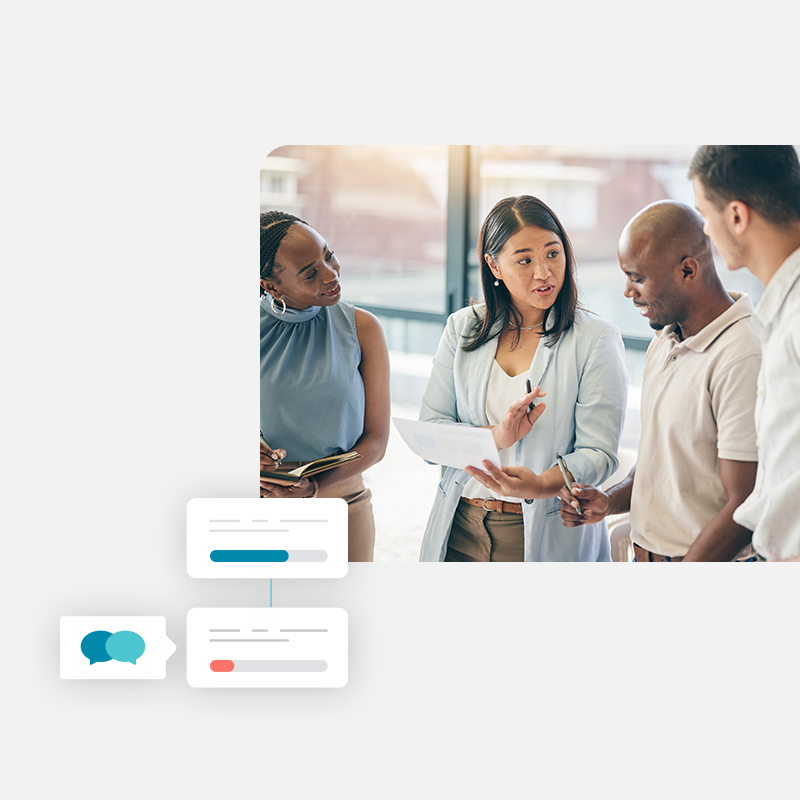Action plans in your employee engagement strategy are like the ignition in your car. You can meticulously plan a road trip to hit everything you want to see but, until you turn that key and start to drive, all of that preparation is nothing but potential energy. Action planning converts that potential into reality, transforming your employee feedback into tangible improvements across your organization.
But action planning isn’t necessarily second nature, especially for HR leaders and managers new to employee engagement. For that reason, we’re going to build on our previous insights on the subject and examine some action plan examples you can use as a starting point. Along the way, we’ll also provide some best practices on particular topics, including:
- Creating your action plans
- Building momentum with quick wins
- Action planning for bigger initiatives
As we said, the action planning process isn’t always instinctual, but that doesn’t mean it’s rocket science, either. Use these examples and insights to inform your own action plans and start seeing the many benefits of improved engagement in your organization.
Creating Your Action Plans
Effective action planning starts by identifying pain points and trends within your organization that you need to address. These could include aspects of your work environment, specific issues with the employee experience or senior leadership, or any number of dynamics in your company. Since the actual process of identifying these issues depends on your choice of employee engagement software, this will vary according to the engagement platform you use.
To make things simple, however, we’ll use Betterworks Engage’s platform as an example.
For any given employee survey report in Betterworks Engage, the system tells you which engagement drivers are performing well in your organization and where you need to improve. For instance, if a report reveals that you need to work on the Feedback & Recognition driver, then you can create an action plan directly from the report using a list of pre-filtered templates.
The point is, assuming you’re using engagement software with integrated action planning, it will have its own process of identifying areas for improvement. Once you’ve targeted those areas, it’s then time to start creating the actual plans using a series of steps.
- Between HR and the managers, leaders, or stakeholders involved, choose a course of action that will address the underlying issue. If you’re new to employee engagement strategies, then using an engagement solution that provides action plan suggestions can be extremely helpful as you get accustomed to the process.
- Choose a leader to supervise and guide the action plan, making sure they’re a good fit for the task.
- If action planning for a larger initiative, divide the overall plan into a series of smaller ones, assigning a leader for each sub-plan. Since all of these smaller plans must work together, be sure to organize everything well according to timelines, tasks, and goals. Once again, the right engagement software can help keep track of these different moving parts and ensure the overall plan stays on track.
- Develop clear objectives for every action plan. Try to use concise language that isn’t vague but clearly spells out your goals with the plan.
- Establish checkpoints and milestones that HR and the action plan leader can use to monitor progress and direction.
- Initiate the action plan.
- After you’ve completed the plan, measure your results and gauge your success with pulse surveys and polls. Use that additional feedback to inform your next series of action plans, changing course if needed to achieve your desired results.
Remember, action planning for improved employee engagement is an ongoing process that builds on itself. Just like your overall engagement strategy, action planning is more a series of refinements rather than something with a definite finish line.
Building Momentum With Quick Wins
After you distribute your initial employee engagement survey, collect the results, and analyze the survey data, there’s a fair chance you’ll end up with several different areas for improvement. While that’s to be expected, particularly for companies just starting their engagement strategy, it leaves you with a decision to make – where should you start with your action planning?

We usually suggest targeting the low-hanging fruit first, the quick wins that will help you build momentum. Once you have some success under your belt and employees see that you’re committed to making improvements, that momentum can sustain you as you tackle more complex issues down the road.
For example, let’s say your employee survey results show that you should focus on the Management engagement driver – a gauge on an employee’s experience and relationship with their direct supervisor – in your accounting department. Perhaps people in accounting feel that their team leader is too distant, making it an area for improvement. HR can take these action items from your survey report, sit down with that team leader and maybe even his or her supervisor, and devise a simple but effective action plan to start addressing the issue.

Obviously, this example is very straight-forward and doesn’t require much preparation. However, the simple act of personal interaction, even if it only lasts a few moments, can make an employee feel appreciated and valued by their manager. According to research, supervisors account for 70% of the variance in individual engagement levels. In other words, even these quick wins can have a significant impact on employee engagement in your organization.
Extending that example, now let’s assume your survey report also revealed a lack of clarity from that same accounting manager regarding messages from company leaders. Once again, an action plan built around the Management or Communication engagement drivers can address this issue.

If employees feel like they’re getting muddled information or unclear direction from the direct supervisor on company-wide initiatives or even departmental goals, skip-level meetings between team members and their supervisors’ boss can help clarify that message. Research indicates that roughly 50% of employees are not entirely clear on their responsibilities at work, so this type of action plan is increasingly common in companies.
Action Planning for Bigger Initiatives
Of course, some action plans are inherently more complex than others, especially when they’re dealing with larger engagement initiatives. We’re going to continue our previous example, now assuming that the lack of clarity in leadership messaging wasn’t just identified in accounting but in several workgroups.
These results indicate more of a systemic issue, where people throughout the company feel a lack of communication from senior leaders. Scheduling skip-level meetings in every department is a good first step, but if the underlying problem is more extensive than just an issue with managers, then you will want to adopt an action plan that’s bigger in scope and reach.

This is a perfect example of a larger plan that you could supplement or divide into different smaller plans. For example, someone would have to organize the actual town hall meetings, and managers would need to plan short follow-ups with their teams. Each of these might require its own action plan. And naturally, the bigger the organization, the more complex the planning would be.
Whatever you’re targeting with your employee engagement action plans, just make sure they address the areas of concern from your survey results. Start small and build on your successes, expanding the scope of your action planning as you become more comfortable with the process. With time, you’ll see improvements in your employee engagement levels that can propel the entire organization forward.
Creating an employee action plan to ensure successful employee engagement will include being able to take feedback from your employees and turn it into true improvements. A good start is requesting such feedback and looking at it with an honest, open mind.
Develop clear objections and assign a well-respected leader to supervise and report back with results. Just be sure to address the feedback that you received, and you’ll be well on your way to high employee engagement.
Employee engagement is based firmly on the idea that, if engaged, an employee will develop a strong connection with the company as a whole. Therefore, strategies to employ this type of culture are best devised by management and team leaders.
Some examples of employee engagement strategies include keeping an open-door policy and welcoming an inclusive culture. These strategies can be geared toward retaining employees and building a productive, solid team environment.
Employee engagement is the most important aspect of ensuring that your team is happy and satisfied with their roles. Management must also interact and communicate with employees to build engagement.
If an employee is not engaged, this can lead to the ever-growing problem with the low employee retention levels that are experienced in the workplace today. If you want to keep a highly skilled employee, building engagement is the first step.


